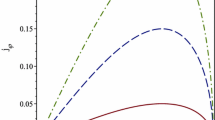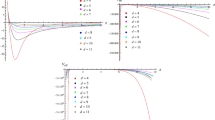Abstract
We construct a class of static, axially symmetric solutions representing razor-thin disks of matter in the Integrable Weyl–Dirac theory proposed in Israelit (Found Phys 29:1303, 1999). The main differences between these solutions and the corresponding general relativistic one are analyzed, focusing on the behavior of physical observables (rotation curves of test particles, density and pressure profiles). We consider the case in which test particles move along Weyl geodesics. The same rotation curve can be obtained from many different solutions of the Weyl–Dirac theory, although some of these solutions present strong qualitative differences with respect to the usual general relativistic model (such as the appearance of a ring-like density profile). In particular, for typical galactic parameters all rotation curves of the Weyl–Dirac model present Keplerian fall-off. As a consequence, we conclude that a more thorough analysis of the problem requires the determination of the gauge function \(\beta \) on galactic scales, as well as restrictions on the test-particle behavior under the action of the additional geometrical fields introduced by this theory.



Similar content being viewed by others
References
Binney, J., Tremaine, S.: Galactic Dynamics, 2nd ed. Princeton University Press, Princeton (2008)
Karas, V., Huré, J.-M., Semerák, O.: Gravitating discs around black holes. Class. Quantum Gravity 21, R1 (2004)
Semerák, O.: Towards Gravitating Discs Around Stationary Black Holes. arXiv:gr-qc/0204025
Bonnor, W.A., Sackfield, A.: The interpretation of some spheroidal metrics. Comm. Math. Phys. 8, 338 (1968)
Morgan, T., Morgan, L.: The gravitational field of a disk. Phys. Rev. 183, 1097 (1969)
Morgan, L., Morgan, T.: Gravitational field of shells and disks in general relativity. Phys. Rev. D 2, 2756 (1970)
Bičák, J., Lynden-Bell, D., Katz, J.: Relativistic disks as sources of static vacuum spacetimes. Phys. Rev. D 47, 4334 (1993)
Vogt, D., Letelier, P.S.: Exact general relativistic perfect fluid disks with halos. Phys. Rev. D 68, 084010 (2003)
Coimbra-Araújo, C.H., Letelier, P.S.: A thin disk in higher-dimensional space-time and dark matter interpretation. Phys. Rev. D 76, 043522 (2007)
Miyamoto, M., Nagai, R.: Three-dimensional models for the distribution of mass in galaxies. Publ. Astron. Soc. Jpn. 27, 533 (1975)
González, G.A., Letelier, P.S.: Exact general relativistic thick disks. Phys. Rev. D 69, 044013 (2004)
Vogt, D., Letelier, P.S.: Relativistic models of galaxies. Mon. Not. R. Astron. Soc. 363, 268–284 (2005)
Coimbra-Araújo, C.H., Letelier, P.S.: Gravity with extra dimensions and dark matter interpretation: phenomenological example via Miyamoto–Nagai galaxy. Braz. J. Phys. 42, 100 (2012)
Begeman, K.G.: HI Rotation Curves of Spiral Galaxies. PhD. Thesis, Rijksuniversiteit Groningen (1987)
Begeman, K.G.: HI rotation curves of spiral galaxies—I.NGC3198. Astron. Astrophys. 223, 47–60 (1989)
de Blok, W.J.G., McGaugh, S.S., Rubin, V.: High-resolution rotation curves of Low Surface Brightness galaxies—II. Mass models. Astrophys. J. 122, 2396–2427 (2001)
de Blok, W.J.G., McGaugh, S.S.: The dark and visible matter content of low surface brightness disc galaxies. Mon. Not. R. Astron. Soc. 290, 533 (1997)
Zurita, A., Relaño, M., Beckman, J.E., Knapen, J.H.: Ionized gas kinematics and massive star formation in NGC 1530. Astron. Astrophys. 413, 73 (2004)
de Blok, W.J.G.: The core-cusp problem. Adv. Astron. 2010, 789293 (2010)
Navarro, J.F., Frenk, C.S., White, S.D.M.: The structure of cold dark matter halos. Astrophys. J. 462, 563 (1996)
Einasto, J.: Dark Matter. arXiv:0901.0632v2 [astro-ph.CO]
Sanders, R.H.: The Dark Matter Problem: A Historical Perspective. Cambridge University Press, Cambridge (2010)
Rodrigues, D.C., Letelier, P.S., Shapiro, I.L.: Galaxy rotation curves from general relativity with renormalization group corrections. JCAP 04, 020 (2010)
Brownstein, J.R., Moffat, J.W.: Galaxy rotation curves without nonbaryonic dark matter. Astrophys. J. 636, 721–741 (2006)
Sanders, R.H., McGaugh, S.S.: Modified Newtonian dynamics as an alternative to dark matter. Ann. Rev. Astron. Astrophys. 40, 263–317 (2002)
Weyl, H.: Gravitation and electricity. In: O’Rafeartaigh (ed.) The Dawning of Gauge Theory, pp. 24–37. Princeton University Press, Princeton (1997)
Dirac, P.A.M.: Long range forces and broken symmetries. Proc. R. Soc. Lond. A 333, 403–418 (1973)
Canuto, V., Adams, P.J., Hsieh, S.-H., Tsiang, E.: Scale-covariant theory of gravitation and astrophysical applications. Phys. Rev. D 16(6), 1643–1663 (1977)
Israelit, M.: Matter creation by geometry in an integrable Weyl–Dirac theory. Found. Phys. 29, 1303 (1999)
Carroll, R.: Remarks on Weyl Geometry and Quantum Mechanics. arXiv:0705.3921v3 [gr-qc]
Israelit, M.: Primary matter creation in a Weyl–Dirac cosmological model. Found. Phys. 32, 295 (2002)
Israelit, M.: Quintessence and dark matter created by Weyl–Dirac geometry. Found. Phys. 32, 945 (2002)
Israelit, M.: A Weyl–Dirac cosmological model with DM and DE. Gen. Relativ. Gravit. 43, 751 (2011)
Mirabotalebi, S., Jalalzadeh, S., Sadegh Movahed, M., Sepangi, H.R.: Weyl–Dirac predictions on galactic scales. Mon. Not. R. Astron. Soc. 385, 986 (2008)
Letelier, P.S.: Stability of circular orbits of particles moving around black holes surrounded by axially symmetric structures. Phys. Rev. D 68, 104002 (2003)
Folland, G.B.: Weyl manifolds. J. Differ. Geom. 4, 145 (1970)
O’Neill, B.: Semi-Riemannian Geometry with Applications to Relativity. Academic Press, New York (1983)
Buchdahl, H.A.: Reciprocal static metrics and scalar fields in the general theory of relativity. Phys. Rev. 115, 1325 (1959)
Griffiths, J.B., Podolský, J.: Exact Space-Times in Einstein’s General relativity. Cambridge University Press, Cambridge (2009)
Taub, A.H.: Space-times with distribution-valued curvature tensors. J. Math. Phys. 21, 1423 (1980)
Arfken, G.B., Weber, H.J.: Mathematical Methods for Physicists, 5th ed. Harcourt Academic Press, Burlington (2001)
Jackson, J.D.: Classical Electrodynamics, 3rd ed. Wiley, New York (1999)
Landau, L.D., Lifshitz, E.M.: Fluid Mechanics, Course of Theoretical Physics vol. 6, 2nd ed. Elsevier, Amsterdam (1987)
Acknowledgments
R.S.S.V. thanks Davi C. Rodrigues for helpful discussions about the astrophysics of galaxies, Mark Israelit for valuable comments on an earlier version of this manuscript and Fundação de Amparo à Pesquisa do Estado de São Paulo (FAPESP) for financial support. This work is dedicated to the memory of Prof. Patricio S. Letelier, who passed away after the elaboration of the first draft of this manuscript.
Author information
Authors and Affiliations
Corresponding author
Additional information
In memoriam to Patricio S. Letelier.
Rights and permissions
About this article
Cite this article
Vieira, R.S.S., Letelier, P.S. Thin-disk models in an integrable Weyl–Dirac theory. Gen Relativ Gravit 46, 1641 (2014). https://doi.org/10.1007/s10714-013-1641-7
Received:
Accepted:
Published:
DOI: https://doi.org/10.1007/s10714-013-1641-7




